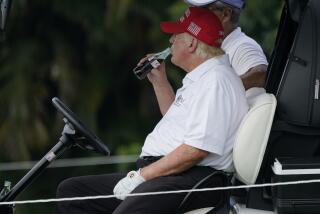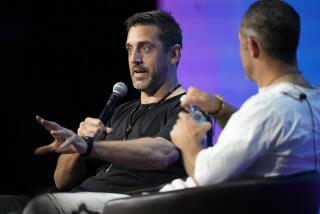Clinton Dresses Down Fashion Industry for ‘Heroin Chic’
- Share via
WASHINGTON — President Clinton on Wednesday accused the U.S. fashion industry of portraying heroin use as glamorous to sell clothes, using the platform of the White House to take a slap at what he termed an “ugly” and “destructive” aspect of popular culture.
“The glorification of heroin is not creative, it’s destructive,” Clinton said. “It’s not beautiful, it is ugly. And this is not about art, it’s about life and death.”
Law enforcement officials are concerned about increased heroin use, particularly among young people. And some social commentators link this trend to pop culture’s so-called “heroin chic”--especially in the fashion industry, where photographic images of skinny, dead-eyed models slouched in sleazy surroundings are a mainstay of advertising campaigns.
In his remarks Wednesday to the U.S. Conference of Mayors, Clinton also announced a decline in methamphetamine use in eight western cities, including Los Angeles, and said that seizures of laboratories producing that drug are up 170%.
Additionally, he declared that the White House has imposed “a vigorous crackdown” on money-laundering operations by drug dealers, including a new requirement that currency exchanges and check-cashing firms register with the U.S. Treasury. Under the money-laundering crackdown, more business will be required to report suspicious activities to federal officials and overseas transfers of as little as $750 will have to be reported to the government, down from $10,000.
“We know this will cut back on money laundering,” the president said. “It will require some efforts . . . but it is worth doing.”
However, it was the president’s unexpected venture into criticism of fashion photography that drew the greatest attention. His remarks were prompted by a recent New York Times article about Davide Sorrenti, a well-regarded fashion photographer who died in February of a heroin overdose at the age of 20.
In raising the issue, Clinton recalled the dark image he held of heroin as a boy in Arkansas and lamented signs that the narcotic seems to have been increasingly accepted by young people and the culture that influences them.
“For most people in our generation . . . we all grew up thinking heroin was the worst thing in the world. And there were these horrible images associated with it--strung-out junkies lying on street corners in decidedly unglamorous ways,” Clinton, 50, told the mayors.
“But we now see in college campuses, in neighborhoods, heroin becoming increasingly the drug of choice. And we know that part of this has to do with the images that are finding their way to our young people.”
By some law enforcement estimates, more than 600,000 Americans use heroin, which has gained popularity at a time when cocaine usage has declined.
Clinton made a point in his remarks to express admiration for fashion leaders who now “are admitting flat-out that images projected in fashion photos in the last few years have made heroin addiction seem glamorous and sexy and cool.”
He added: “And as some of the people in those images start to die now, it’s become obvious that is not true.”
Indeed, some fashion experts believe that Clinton was assailing a trend that has subsided in recent months.
Clinton’s comments were not the first time he has leveled criticism at the fashion industry or reached into the world of popular culture for a political issue. At a campaign fund-raising dinner in 1995, for instance, he complained that Calvin Klein ads depicting youthful models in provocative poses were “outrageous.”
“It is wrong to manipulate these children, to use them for commercial benefit,” Clinton declared at the time. Calvin Klein later withdrew the ads.
On Wednesday, the leader of the mayors’ delegation applauded Clinton’s comments. “These are young, vulnerable people,” said Chicago Mayor Richard M. Daley. “The industry has to understand that. They have to take some responsibility, and I believe they will.”
More to Read
Sign up for Essential California
The most important California stories and recommendations in your inbox every morning.
You may occasionally receive promotional content from the Los Angeles Times.










